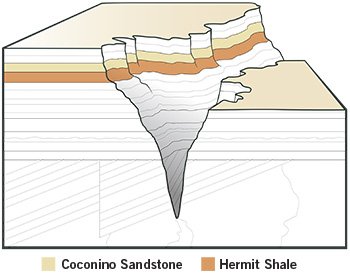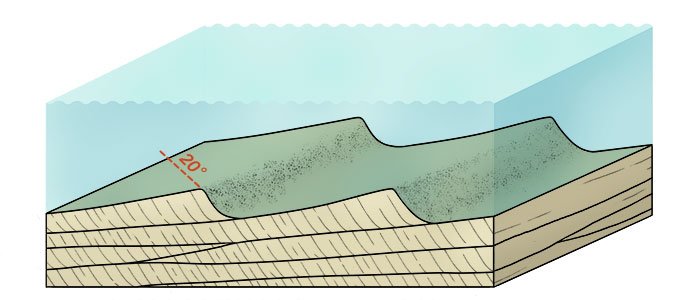
Coconino Sandstone—The Most Powerful Argument Against the Flood?
Geology
The Flood is impossible because one of the Grand Canyon’s layers was deposited in a desert. Or so evolutionists claim. Do the facts back them up?
When creationists suggest that a worldwide Flood deposited all the layers in the Grand Canyon, secular geologists laugh. “That can’t be,” they say, “because one of the canyon’s major layers was formed in a desert over millions of years. It’s filled with fossilized sand dunes, which are windblown deposits that have hardened into stone. You can’t deposit desert sands during a global flood!”
The Coconino Sandstone (Figure 1a), whose buff-colored sand piles up as thick as 300 feet (90 m) in the Grand Canyon area and 1,000 feet (300 m) in other areas, is one of the most common evidences raised against the Genesis Flood. The arguments sound pretty compelling. So nearly a decade ago, I joined a team of creation geologists in an unprecedented research project to examine the claims firsthand, including dozens of field trips and careful laboratory work.1
The debate is whether these fossilized sand dunes formed by wind or underwater. Features of the original dunes and the wear and tear on the sand grains would be very different under these two conditions. Underwater dunes sometimes have gentler slopes and less abrasion of sand grains. Our job as geologists was to determine the precise characteristics of the Coconino cross-beds and compare them to modern dunes, both in deserts and underwater.
Arthur Strahler is typical of the geologists who self-confidently state that the evidence against the Flood is indisputable: “The evidence of subaerial [windblown] origin of the dune-sand formations is undisputed as to its significance by mainstream geology; in itself it is sufficiently weighty to totally discredit the biblical story of the Flood of Noah as a naturalistic phenomenon occurring in one year.”2
Two other geologists are frequently quoted—Young and Stearley—who argue that the Coconino sand grains are characteristic of modern deserts,3 and the dunes have steep angles and vertebrate footprints that are also characteristic of desert settings.
The problem is that these scientists never went into the field to confirm whether these claims about the Coconino Sandstone are true!
Careful study shows the Coconino Sandstone simply does not have the same characteristics as modern desert sand dunes. Our multi-year study uncovered seven common myths about this rock formation. The observable facts support a much different conclusion: the sand was deposited underwater.
Myth #1—The Fossilized Sand Dunes in the Coconino Sandstone Are Steep Like Those Found in Modern Deserts
In modern deserts, dry sand avalanches down the back sides of desert sand dunes at a steep angle of repose (about 32˚). As the windblown sand becomes too steeply piled, it avalanches again down the slope to make a distinctive tongue-like deposit (Figure 2a). This process produces “cross-bedding” as seen in Figure 3.
Observable facts. We measured over 200 cross-bed dips in the Coconino and found an average dip of only about 20˚.4 Our measurements are comparable to those that other geologists have made.5 Some may claim that the weight of the overlying rock formations must have compacted the sandstone and thus lowered the steep angles. However, when we inspected the rock under microscopes, we found no evidence of such extreme compaction. It appears the 20˚ angle is very close to the original. Interestingly, underwater sand dunes that commonly occur today on the continental shelves have dips comparable to what we found in the Coconino.6
Myth #2—The Sand Grains of the Coconino Sandstone Are Well-Rounded Like Those of Modern Sand Dunes
In modern deserts, sand grains (especially the larger ones) become rounded as wind blows them about. Sharp angular corners get broken off during grain-to-grain collisions, and the grains become spherical or “round” in shape.
Observable facts. Geologists use something called the rho scale7 to determine rounding for sand grains: “0” being the most angular and “6” being perfectly spherical or round. We collected over 100 different Coconino samples from the breadth and depth of the formation and measured their rounding using a standard tool among geologists—a petrographic microscope. The most rounded Coconino grains, found at Chino Point, had a rho value of only 3.4. The most angular grains, found at Warm Springs Canyon, had a rho value of 2.8. The Coconino grains are sub-angular to sub-rounded, not “well-rounded” (a 5 or above; Figure 4).
It appears that claims of “well-rounded” grains are based on the assumption this is a windblown deposit, not on careful laboratory and field work. Our groundbreaking results have been presented at geology meetings,8 and they don’t suggest a desert origin for the Coconino.
Myth #3—The Sand Grains of the Coconino Sandstone Are Well-Sorted, Just Like Those of Modern Sand Dunes
The sand grains in desert dunes are usually all very similar in size, or “well-sorted.” When the wind transports sand, it tends to carry and deposit only a select group of sizes, dependent on wind speed.
Observable facts. Our studies of both modern sand dunes9 and of the Coconino10 found that the Coconino’s sand grains are not as well-sorted as those in modern dune sands (Figure 5). In most cases, the Coconino can best be described as moderately sorted or poorly sorted, based on over 100 samples studied under the microscope.
When most people look at the Coconino grains, they use a low-power hand lens as they walk along a hiking trail. Very few have collected samples and cut thin sections for microscopic study.11 When this is done, many smaller grains can be seen between the larger ones, revealing the limited amount of sorting, as we would expect from underwater deposition.
Myth #4—The Coconino Desert Spread Over a Huge Floodplain and Filled Open Mud Cracks on that Floodplain
Secular geologists assume that the Coconino sand formed on top of dry, cracked mud. Underneath the Coconino Sandstone are the brown siltstones of the Hermit Formation, made of mud turned into rock. In many places at the top of the Hermit Formation, the mud has cracks filled with sand (Figure 6). The story goes that the Hermit Formation was deposited across a giant river floodplain. The river then dried up, causing the mud to dry and crack. Subsequently, the Coconino desert blew in, filling the cracks with sand.
The observable facts. If wind gradually filled the deep cracks with sand, layer after layer, the fillings should have horizontal layers in them. But when we studied these features, we could not find any evidence of horizontal layering, and only occasionally did we find vertical layering within the cracks.
The facts support a much different conclusion: the sand was deposited underwater.
Further study revealed a very different story. Over a wide area, the cracks had a pattern like you would find resulting from a massive earthquake. The cracks were deepest near the Bright Angel Fault, a major rupture in the earth that cuts right through Grand Canyon. We found that the cracks shortened and eventually disappeared as we moved away from the fault, probably because the energy from the earthquake was dissipating.
Based upon these data and other features, we have interpreted the sand-filled cracks as a special phenomenon known as sand injectites12 that form in much the same way in which oil companies perform hydraulic fracking. During intense earthquakes, high-pressure, water-saturated sand flows like a fluid (it becomes liquefied). Our team concluded that an earthquake caused the sand at the bottom of the Coconino to become liquefied and flow forcefully down into the Hermit Formation, making the sand-filled cracks.
Myth #5—Vertebrate Animals Left Footprints in the Coconino Sandstone, Which Means Small, Four-Legged Animals Were Walking on Steep Slopes of Desert Dunes
The observable facts. The tracks have other characteristics that don’t match tracks left in desert sand dunes. One of the most interesting things about these footprints is that the animals were almost always traveling up the dune slopes (Figure 7). Additionally, the tracks often seem to begin and end suddenly, and the toes are often pointed in odd directions, unrelated to the animal’s direction of travel. Climbing to escape rising floodwater would explain these features.
Leonard Brand,13 who has done the most field work on these footprints, has also done laboratory studies of salamanders walking on various types of sand—dry, wet, and underwater. The experimental tracks that best matched the Coconino tracks were made underwater. Flowing water would also explain the sudden appearance and disappearance of many tracks, as the currents picked up animals and they landed in new places.
Myth #6—Raindrop Prints in the Coconino Sandstone Prove Its Desert Origin
These rare features in the Coconino are often interpreted as fossilized raindrop prints that could have formed only during desert squalls over dry sand.
The observable facts. These pock marks often occur in “rows,” unlike modern raindrop prints on dry sand. They penetrate up to 1 cm through the sand, or are formed by small round nodules that have fallen out of the rock (Figure 8). When modern raindrops hit dry sand, they rarely make nice “craters.” Instead, they typically make a mottled surface. There is uncertainty as to what made the dimples in the Coconino, but they don’t appear to be from raindrops.
Myth #7—The Sand Grains of the Coconino Are “Frosted,” Meaning Their Surfaces Have Been Damaged by Multiple Grain-to-Grain Collisions While Being Blown About in a Desert
In deserts, the wind picks up sand grains and forcefully throws them against each other. This causes small imperfections on the surfaces of the quartz sand grains and gives them a “frosted” appearance when viewed with magnification. The same thing happens to glass when sand is blown against it. This is known as mechanical frosting, since physical (or mechanical) forces produce it.
The observable facts. Experiments and observations in laboratories and deserts show mechanical frosting happens more often to larger sand grains than smaller ones like those found in the Coconino.14 Smaller sand grains can’t gain enough momentum to strike one another with sufficient force to cause frosting. The sand grains of the Coconino are frosted (Figure 9), but their average size is so small that a mechanical cause is unlikely.
So what caused the frosting? Our studies with a scanning electron microscope showed that the culprit is probably chemical corrosion (caused by water) and not mechanical. A study of the Navajo Sandstone found a similar result.15 Thus, frosting is not convincing evidence of a desert origin
A Warning
So how is it that so many leading geologists have been so wrong about the Coconino, and where have all these myths come from? Perhaps they assume these characteristics are present in the Coconino because the standard geology textbooks and reference works list it as a classic sandstone formed from windblown sand. Perhaps these authors have relied upon what others have said without carefully examining the formation for themselves. Unless geologists have reason to reexamine the widely accepted reports of other geologists, they usually rely on their claims without question.
This is a good warning to all of us. No one knows everything, and we depend on others to fill in the gaps. We should always hold our scientific views lightly, and be willing to reexamine them. If popular scientific claims contradict Scripture, especially, we know something is wrong with the research or the interpretations.
Because creationists saw flaws with the windblown sand story in light of the Bible, they chose to study this formation more carefully. This research has revealed many problems with often-made claims. No evidence can “discredit the biblical story of the Flood of Noah,” as Strahler claimed. Upon further investigation, the Coconino Sandstone actually provides tremendous supporting evidence for the Flood and confirms the unquestionable truth of God’s Word!

Coconino Sandstone: Desert or Flood?
Was the Coconino Sandstone deposited in a dry desert or during Noah’s Flood? Secular geologists say it was a desert. So a team of creation geologists went into the field to look closely at the seven “facts” used to support the desert hypothesis. They discovered that they match the Flood interpretation instead!
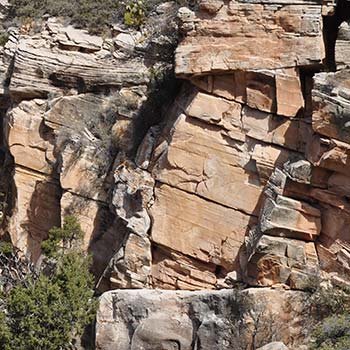
MYTH #1 STEEP, FOSSILIZED DESERT DUNES
In modern deserts, dry sand avalanches at a steep angle of about 32˚. Creation geologists measured over 200 angles in the Coconino and found an average of only about 20˚, an angle more consistent with measurements made on modern underwater sand dunes.
FIGURE 3
Outcrop of the Coconino
Sandstone in the Grand
Canyon. Note the crossbedding
(or angled layers).
Photo by JHW.
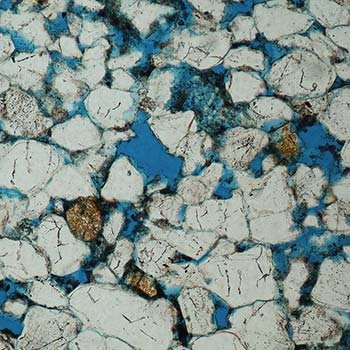
MYTH #2 WELL-ROUNDED SAND GRAINS
Desert sand grains become rounded as wind blows them about. But the Coconino sand grains are best described as subrounded or sub-angular. Creation geologists carefully examined over 100 samples under the microscope to determine this.
FIGURE 4
A typical subangular
sample from New Hance
Trail in the Grand Canyon.
The white areas are
quartz sand grains.
Photo by JHW.
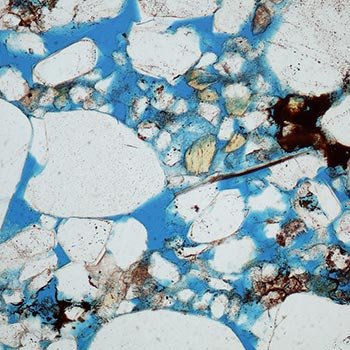
MYTH #3 WELL-SORTED SAND GRAINS
Sand grains in desert dunes are usually very similar in size, or “well sorted,” because the wind carries only select sizes. But Coconino sand grains are best described as moderately or poorly sorted. Creation geologists carefully studied over 100 thin sections, widely spaced in the Coconino, to determine this.
FIGURE 5
Sample of poorly sorted
grains from Warm Springs
Canyon. The white areas
are quartz sand grains.
Photo by JHW.
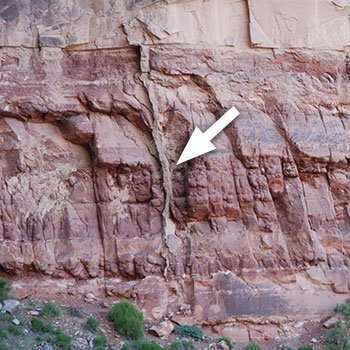
MYTH #4 MUD CRACKS FILLED WITH WINDBLOWN SAND
If sand blows on top of dry, cracked river mud, it slowly fills the cracks with thin, horizontal layers of sand. Creation geologists did field research and found evidence that the Coconino sand was wet and forcefully injected into the mud below. They could not find any evidence of horizontal layering.
FIGURE 6
Sand-filled cracks extend
from the Coconino Sandstone
down into the Hermit
Formation along Bright
Angel Trail, Grand Canyon.
The deep crack is about
36 feet (12 m) long.
Photo by RS.

MYTH #5 ANIMAL FOOTPRINTS ON STEEP DESERT DUNES
Unlike animals plodding across desert sand, the tracks in Coconino Sandstone begin and end suddenly like the animals are in water being driven by a current. The toes often point in unusual directions, and the animal prints are sometimes moving sideways.
FIGURE 7
Footprints in the Coconino
Sandstone along Hermit
Trail, Grand Canyon.
Photo by JHW.

MYTH #6 RAINDROP PRINTS ON DRY SAND
The Coconino has rare features often called fossilized “raindrop” prints. But when rain hits dry sand, it typically leaves a mottled surface. In contrast, the Coconino prints often occur in “rows” and leave nice “craters.” The cause is uncertain, but they don’t appear to be from raindrops.
FIGURE 8
“Raindrop” prints in the
Coconino (A) form stripes
and deep craters. Modern
rain drops in dry sand (B)
are randomly distributed
and resemble a
mottled appearance.
Photos by JHW.
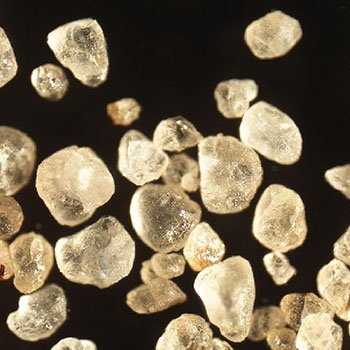
MYTH #7 “FROSTED” SAND GRAINS BLOWN BY WIND
Desert winds smash sand grains against each other, causing a “frosted” appearance. But lab experiments show that wind doesn’t give small sand grains enough momentum to become frosted. The culprit is probably chemical corrosion (caused by water), shown by a scanning electron microscope.
FIGURE 9
These Coconino sand
grains were examined under
a microscope. The frosting
occurred by chemical
corrosion processes caused
by water, not by wind.
Photo by JHW.
Coconino Sandstone: Desert or Flood?
Was the Coconino Sandstone deposited in a dry desert or during Noah’s Flood? Secular geologists say it was a desert. So a team of creation geologists went into the field to look closely at the seven “facts” used to support the desert hypothesis. They discovered that they match the Flood interpretation instead!
Myth #1: Steep, Fossilized Desert Dunes
In modern deserts, dry sand avalanches at a steep angle of about 32˚. Creation geologists measured over 200 angles in the Coconino and found an average of only about 20˚, an angle more consistent with measurements made on modern underwater sand dunes.

Photo by JHW.
Figure 3: Outcrop of the Coconino Sandstone in the Grand Canyon. Note the crossbedding (or angled layers).
Myth #2: Well-Rounded Sand Grains
Desert sand grains become rounded as wind blows them about. But the Coconino sand grains are best described as subrounded or sub-angular. Creation geologists carefully examined over 100 samples under the microscope to determine this.

Photo by JHW.
Figure 4: A typical subangular sample from New Hance Trail in the Grand Canyon. The white areas are quartz sand grains.
Myth #3: Well-Sorted Sand Grains
Sand grains in desert dunes are usually very similar in size, or “well sorted,” because the wind carries only select sizes. But Coconino sand grains are best described as moderately or poorly sorted. Creation geologists carefully studied over 100 thin sections, widely spaced in the Coconino, to determine this.

Photo by JHW.
Figure 5: Sample of poorly sorted grains from Warm Springs Canyon. The white areas are quartz sand grains.
Myth #4: Mud Cracks Filled with Windblown Sand
If sand blows on top of dry, cracked river mud, it slowly fills the cracks with thin, horizontal layers of sand. Creation geologists did field research and found evidence that the Coconino sand was wet and forcefully injected into the mud below. They could not find any evidence of horizontal layering.

Photo by JHW.
Figure 6: Sand-filled cracks extend from the Coconino Sandstone down into the Hermit Formation along Bright Angel Trail, Grand Canyon. The deep crack is about 36 feet (12 m) long.
Myth #5: Animal Footprints on Steep Desert Dunes
Unlike animals plodding across desert sand, the tracks in Coconino Sandstone begin and end suddenly like the animals are in water being driven by a current. The toes often point in unusual directions, and the animal prints are sometimes moving sideways.

Photo by JHW.
Figure 7: Footprints in the Coconino Sandstone along Hermit Trail, Grand Canyon.
Myth #6: Raindrop Prints on Dry Sand
The Coconino has rare features often called fossilized “raindrop” prints. But when rain hits dry sand, it typically leaves a mottled surface. In contrast, the Coconino prints often occur in “rows” and leave nice “craters.” The cause is uncertain, but they don’t appear to be from raindrops.

Photo by JHW.
Figure 8: “Raindrop” prints in the Coconino (A) form stripes and deep craters. Modern rain drops in dry sand (B) are randomly distributed and resemble a mottled appearance.
Myth #7: “Frosted” Sand Grains Blown by Wind
Desert winds smash sand grains against each other, causing a “frosted” appearance. But lab experiments show that wind doesn’t give small sand grains enough momentum to become frosted. The culprit is probably chemical corrosion (caused by water), shown by a scanning electron microscope.

Photo by JHW.
Figure 9: These Coconino sand grains were examined under a microscope. The frosting occurred by chemical corrosion processes caused by water, not by wind.
Related Videos
Coconino Sandstone Field Research with Dr. John Whitmore
Answers Magazine
July–September 2015
This issue focuses on five powerful evidences that confirm creation and leave unbelievers without excuse.
Browse IssueFootnotes
- The study had many participants, including Ray Strom, Paul Garner, Stephen Cheung, and Guy Forsythe, resulting in many scientific publications, presentations, and abstracts within the scientific community. John Whitmore was the lead investigator. The project was funded by the Institute for Creation Research, Ray Strom, and several others. Cedarville University provided logistical support. Two major scientific papers in the Answers Research Journal contain supporting documentation for the present article: “Intraformational Parabolic Recumbent Folds in the Coconino Sandstone (Permian) and Two Other Formations in Sedona, Arizona (USA),” January 21, 2015; and “Petrology of the Coconino Sandstone (Permian), Arizona, USA,” December 10, 2014.
- A. N. Strahler, Science and Earth History—The Evolution/Creation Controversy (Amherst, New York: Prometheus Books, 1999), 217.
- D. A. Young and R. F. Stearley, The Bible, Rocks and Time (Downers Grove, Illinois: InterVarsity Press, 2008).
- M. K. Emery, S. A. Maithel, and J. H. Whitmore, “Can Compaction Account for Lower-Than-Expected Cross-Bed Dips in the Coconino Sandstone (Permian), Arizona?” Geological Society of America Abstracts with Programs 43 (5): 430.
- P. Reiche, “An Analysis of Cross-Lamination; the Coconino Sandstone,” Journal of Geology 46 (7): 905–932.
- P. A. Garner and J. H. Whitmore, “What Do We Know about Marine Sand Waves? A Review of Their Occurrence, Morphology, and Structure,” Geological Society of America Abstracts with Programs 43 (5): 596.
- R. L. Folk, “Student Operator Error in Determination of Roundness, Sphericity, and Grain Size,” Journal of Sedimentary Petrology 25 (4): 297–301; M. C. Powers, “A New Roundness Scale for Sedimentary Particles,” Journal of Sedimentary Petrology 23 (2): 117–119.
- J. H. Whitmore and R. Strom, “Textural Trends in the Coconino Sandstone, Central and Northern Arizona, USA,” Geological Society of America Abstracts with Programs 42 (5): 428.
- J. H. Whitmore, “Preliminary Report and Significance of Grain Size Sorting in Modern Eolian Sands,” 2010 Creation Geology Society Abstracts, 8–9.
- J. H. Whitmore and S. Maithel, “Preliminary Report on Sorting and Rounding in the Coconino Sandstone,” 2010 Creation Geology Society Abstracts, 9–10.
- We believe that William Lundy is the only person who has widely sampled and studied the Coconino, other than ourselves. W. L. Lundy, “The Stratigraphy and Evolution of the Coconino Sandstone of Northern Arizona,” University of Tulsa (Masters’ thesis, 1973), Tulsa, Oklahoma. He also thought subaqueous sand waves were the best explanation for the Coconino.
- J. H. Whitmore and R. Strom, “Sand Injectites at the Base of the Coconino Sandstone, Grand Canyon, Arizona (USA),” Sedimentary Geology 230 (2010): 46–59.
- L. R. Brand, “Footprints in the Grand Canyon, Origins 5 (2): 64–82; L. Brand, “Field and Laboratory Studies on the Coconino Sandstone (Permian) Vertebrate Footprints and Their Paleoecological Implications,” Palaeogeography, Paleaeoclimatology, Palaeoecology 28: 25–38; L. R. Brand and T. Tang, “Fossil Vertebrate Footprints in the Coconino Sandstone (Permian) of Northern Arizona: Evidence for Underwater Origin,” Geology 19: 1201–1204.
- K. Pye and H. Tsoar, Aeolian Sand and Sand Dunes (Berlin: Springer-Verlag, 2009); P. H. Kuenen and W. G. Perdok, “Experimental Abrasion 5: Frosting and Defrosting of Quartz Grains,” Journal of Geology 70 (6): 648–658.
- J. E. Marzolf, “Sand-grain Frosting and Quartz Overgrowth Examined by Scanning Electron Microscopy: The Navajo Sandstone (Jurassic (?)), Utah,” Journal of Sedimentary Petrology 46 (4): 906–912.
Recommended Resources

Answers in Genesis is an apologetics ministry, dedicated to helping Christians defend their faith and proclaim the good news of Jesus Christ.
- Customer Service 800.778.3390
- Available Monday–Friday | 9 AM–5 PM ET
- © 2026 Answers in Genesis


